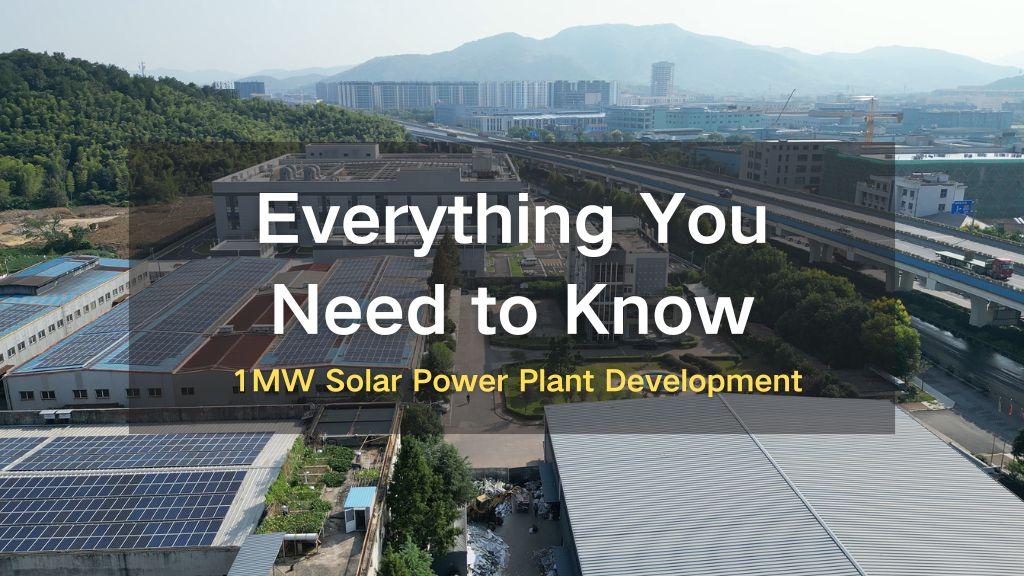Everything You Need to Know About 1MW Solar Power Plant Development
Southeast Asia is a booming hub for solar investment, attracting factory owners, investors, and intermediaries. This guide provides a comprehensive overview of the entire 1MW solar power plant development process, covering project initiation, financing options, EPC partnerships, and energy storage strategies.

Key Aspects of 1MW Solar Power Plant Development
1. Development Stages: Six Critical Steps
·Preliminary Research → Feasibility Study → Financing → EPC Tendering → Construction → Grid Connection
2. Financing Essentials
·Develop a feasibility report including IRR (Internal Rate of Return) projections.
·Engage multiple financing channels: government funds, banks, and industry investors.
3. EPC Collaboration
·Provide 12 key data points, including land status, grid access, and meteorological conditions, to ensure precise design and efficient project execution.
4. Energy Storage Strategy
·Recommended capacity: 10%-20% of solar output (2-4 hours of storage) to mitigate grid fluctuations and leverage peak-valley price differences.

Step-by-Step Process for 1MW Solar Power Plant Development
Stage 1: Preliminary Research (1-3 months)
Key Tasks:
·Assess resource availability and regulatory compliance.
Action Items:
·Gather annual solar irradiation data and prioritize industrial land use.
·Confirm government incentives like FIT (Feed-in Tariff), import tax reductions, and grid approval processes (e.g., Vietnam requires EVN approval).
Stage 2: Feasibility Study (2-4 weeks)
Key Outputs:
·Technical Plan & Financial Model
Essential Data:
·Power generation simulation (using PVsyst software; estimated 1.3-1.5 million kWh/year per 1MW system).
·Investment Returns: Initial cost of $700,000-$900,000, with IRR exceeding 12% to attract investors.
Stage 3: Financing (1-6 months)
Funding Sources | Advantages | Requirements |
| Energy Investment Funds | High capital availability, expertise | PPA (Power Purchase Agreement) as collateral |
| Local Commercial Banks | Lower interest rates (5%-8%). | Land mortgage |
| Industry Investors | Potential integration with solar component procurement. | Clear exit strategy |
Required Documents:
·Feasibility study, PPA agreement, land-use permit, and environmental impact report.
Stage 4: EPC Tendering & Design (2-3 months)
Required EPC Data:
·Site Data: GPS coordinates, topography, geological survey, meteorological conditions (irradiation, temperature, wind speed).
·Technical Specifications: Module type (monocrystalline 540W+), inverter details, grid connection parameters.
·Contractual Documents: Land lease agreements, grid connection permits, EPC contract templates specifying timelines and penalties.
Stage 5: Construction & Grid Connection (4-6 months)
Key Control Points:
·Quality Assurance: Module delivery inspection (EL defect testing).
·Grid Connection: Grid compliance varies; for example, the Philippines requires NGCP certification, while Thailand mandates MEA/PEA approval.
Energy Storage Recommendations: Balancing Capacity & Returns

1. Why Storage is Essential
·Unstable grids in Southeast Asia (e.g., Myanmar, Indonesia) increase curtailment risks.
·Some governments promote solar + storage incentives (e.g., Thailand’s TOU pricing policy).
2. Storage System Design
·Capacity: 10%-20% of PV capacity (100-200kW/1-2MWh per 1MW solar plant).
·Duration: 2-4 hours (to match peak demand periods).
·Technology: LFP (Lithium Iron Phosphate) batteries (≥6,000 cycles) with PCS (bi-directional inverter).
3. Economic Benefits
·Initial CAPEX increases by 15%-25%, but IRR improves by 2%-3% through peak-hour electricity price arbitrage.

Actionable Insights for Different Stakeholders
1. Factory Owners
·Opt for rooftop or ground-mounted systems to cut electricity costs.
·Pay close attention to PPA pricing terms.
2. Investors
·Evaluate off-taker credit ratings (e.g., Vietnam’s EVN rating).
·Assess government support for solar + storage projects.
3. Intermediaries
·Clarify commission structures (typically 1%-3% of total investment).
·Align EPC providers with suitable investors.
Conclusion
Southeast Asia presents immense opportunities for solar investment, but policy and grid conditions vary significantly. Mastering project development milestones, securing strong financing, and optimizing energy storage solutions are crucial for success. Engaging local legal and energy consulting firms can mitigate compliance risks and accelerate investment returns.